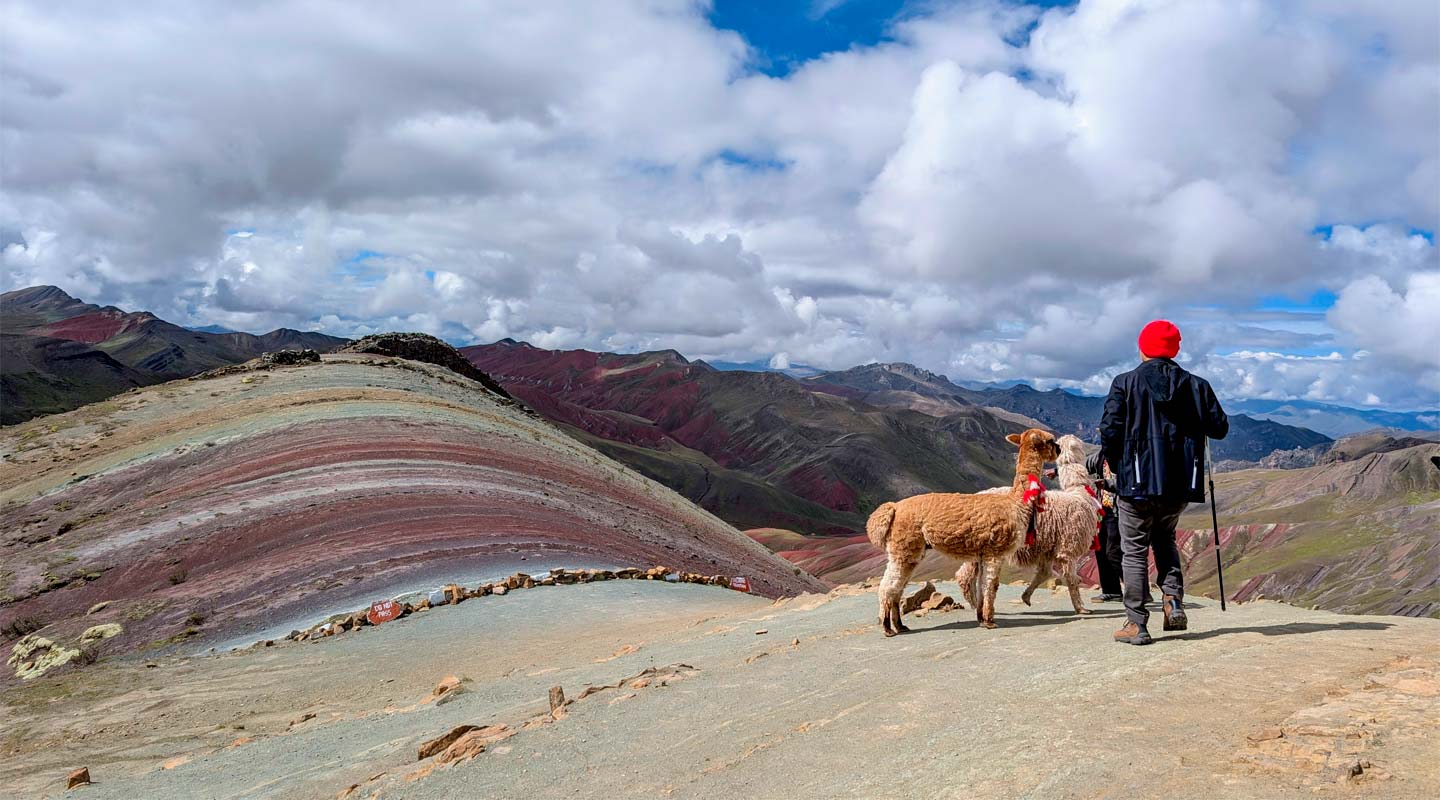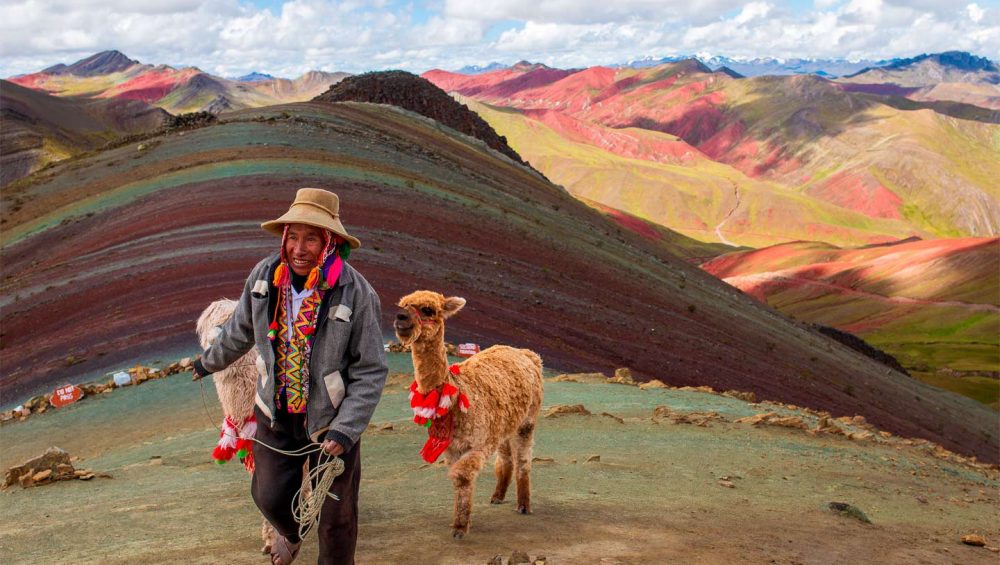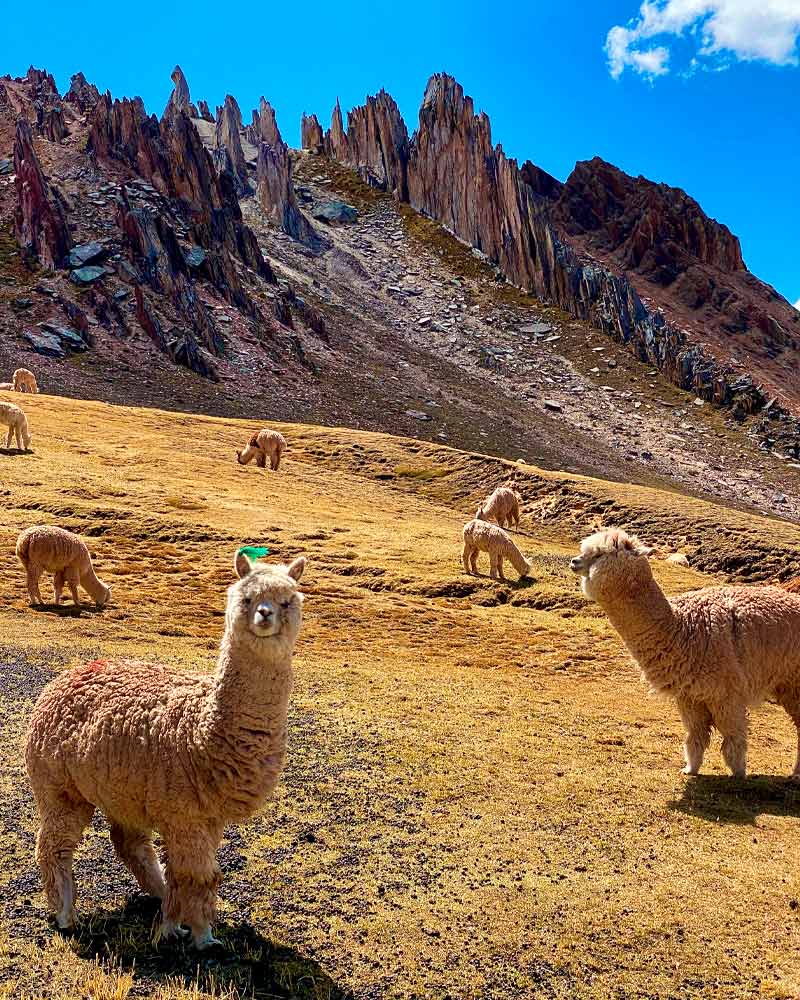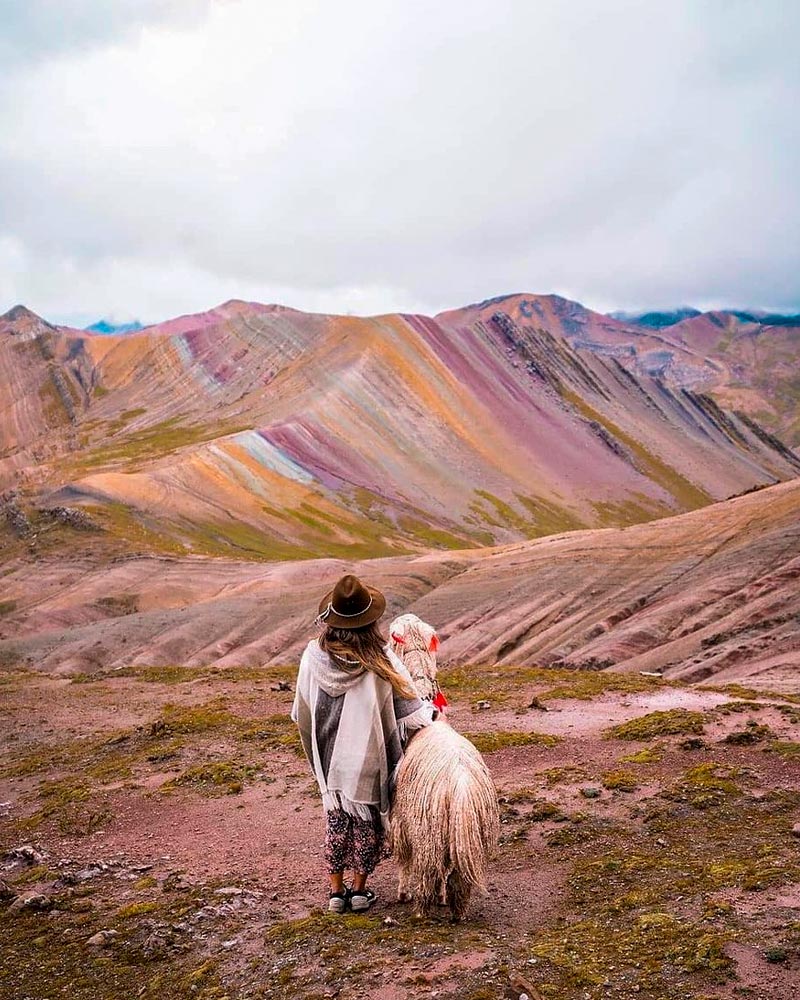Hidden among the views of the Peruvian Andes, Palccoyo mountain is a great choice for those who want a calm, quiet, and stunning visual experience. Unlike the well-known Rainbow Mountain (Vinicunca), this other spot offers views that are just as amazing but in a much more relaxed setting.
Palccoyo is special because of its chain of colorful mountains, its unique rock shapes like the “stone forest“, and the wide view of the whole Andean valley. This lets visitors enjoy a wonderful natural show. So, if you are thinking of putting this great place in your travel plans, this guide will help you a lot. Here you will find out everything about Palccoyo: how to get there, what to expect from the trip, helpful tips, and the best advice to make your visit unforgettable.
What is Palccoyo?
Palccoyo is another amazing natural wonder in the Andean region of Peru, known for its impressive colorful mountain range. It sits at about 16,076 feet above sea level and stands out for its three colorful mountains that can be seen along the way. All of them were formed by minerals building up and wearing away over millions of years. Its red colors come from iron, the green from chlorites, the yellow from limonites, and the purple and blue from a mix of other mineral bits.
Location and How to Get There
Palccoyo mountain is in the Checacupe district, Canchis province, within the Cusco region. This place is about 62 miles southeast of Cusco city, making it a great choice for a day trip. But, if you are wondering how the path to this mountain is, here’s how to get there in 2 simple steps:
Step 1: Route from Cusco to Checacupe
The trip to Palcoyo starts early in the morning from Cusco. You take a bus, shared taxi, or taxi south on the Cusco–Sicuani road (Panamericana Sur Route), passing through towns like Urcos and Cusipata, until you reach the small town of Checacupe, after about 3 hours of travel. Checacupe is also a cultural attraction, with its old stone bridge and its 17th-century church.
Step 2: Access to the Mountain
From Checacupe, you continue on a dirt road for about another hour, going up through country views, mountains, and high Andean communities until you reach the start of the walk, located at almost 15,748 feet above sea level. From this point, the trip continues on foot along a path that goes through Andean grasslands and natural viewpoints that slowly show the beauty of the Palccoyo Mountain Cusco range. Also, in less than an hour, you reach the main viewing point, from where you can see the Palccoyo rainbow mountain, surrounded by an impressive view of Andean peaks, deep valleys, and clear skies.
Organized Tour Option
For more ease, many travelers choose organized tours that leave from Cusco. These tours include:
- Round-trip transport in a tourist vehicle
- A guide who knows about Andean land, history, and culture
- Typical breakfast and lunch from the region
- Basic medical help for altitude sickness
- Short stops in towns along the way like Checacupe or Cusipata

The Palccoyo Hike
The walk to Palccoyo covers about 2.5 km. The path goes over a mix of tall grass and loose rocks. From the start, the slope is gentle and steady, with a total rise of only 100 m, which makes it easy to keep an even pace without steep parts or stairs.
Along the way, the view changes between low bushes, worn-out rocks, and small streams. It’s common to see grassy areas where alpacas and llamas eat, as well as Andean birds. Also, the weather can change quickly: the sun can be strong in the morning, and the temperature can drop several degrees in just minutes.
When you reach the main viewpoint, you can already see the three colored stripes that make Palccoyo special. From that spot, you get wide views of the valley, the snowy peaks of Ausangate, and the colorful hillsides that gave it the nickname “rainbow mountain“.
Duration
- 45 min – 1 hr (one way): Keeping a steady pace of about 3 km/h and with short breaks of 1–2 min every 300 m, the walk up takes less than an hour.
- 1 hr – 1 hr 15 min (return): Going down is faster because of gravity and less effort needed when going down the slope.
Difficulty
- Gentle slope: With a 100 m rise spread over 2.5 km, there are no very steep parts.
- Mixed ground: Areas of grass and loose rocks that need hiking shoes with good soles.
- Continuous signs: Stakes every 200 m and painted crosses at key points; the path is easy to follow without a guide.
Main Attractions of Palcoyo
The trip through Palccoyo offers more than just the view of its colorful stripes: the area has unique rock shapes, views of the snowy Ausangate, and a chance to see typical high-altitude animals up close. Below are the main attractions that complete the experience:
Stone Forest
A few minutes from the main viewpoint, there is a “forest” of large rocks and columns formed by the wearing away of old volcanic layers. These rocks, some up to 3 meters tall, have cracked textures and create natural mazes with small caves. Walking among these shapes lets you see the natural processes that have shaped the Andean land for millions of years.
Wide Views of Snowy Ausangate
Far from the Palccoyo rainbow mountain, you can see Ausangate, the highest mountain in the Cusco region at 6,384 m above sea level. On clear days, the difference between the colors of Palccoyo’s hillsides and the white of Ausangate offers a chance to take a photo with great depth and contrast.
Seeing Local Animals
The high-altitude environment around Palccoyo is home to alpacas, llamas, and vicuñas. It’s common to see herds eating in grassy areas near the path and, with some patience, to photograph single vicuñas. These Andean camelids add presence and life to the view; by stopping a few feet away, visitors can see their striking fur and special features.
Comparison: Palccoyo vs. Vinicunca
Both mountains, Palccoyo and Vinicunca, are known for their amazing colored stripes that decorate their sides, naturally made by minerals settling. However, even though they share that visual beauty, they offer very different experiences to visitors. Here we show you a clear comparison to help you decide which one is better for your travel style.
| Feature | Palccoyo |
Vinicunca (Rainbow Mountain) |
| Accessibility | Easier: short walk of 1 to 1.5 hours | Harder: walk of 3 to 4 hours |
| Maximum Altitude | Approx. 4,900 m above sea level | Approx. 5,200 m above sea level |
| Difficulty Level | Low to moderate | Moderate to high |
| Number of Visitors | Fewer, quiet atmosphere | Very crowded, especially in high season |
| Additional Landscape | Stone forest, three rainbow mountains | Panoramic view of a single main mountain |
| Ideal for | Families, people with physical limits, those seeking peace and nature | Adventurers, photographers, travelers looking for challenges |
| Tour Cost | Slightly less | Usually more expensive due to demand |
Which One to Choose?
- Choose Palccoyo if you prefer to avoid crowds, walk less, and still enjoy a colorful and amazing landscape. It is perfect for those looking for an easier walk, getting used to the altitude, or traveling with children.
- Choose Vinicunca if you want to have the classic, challenging experience and photograph Peru’s most famous rainbow mountain. It is good to be well used to the altitude and in good physical shape to enjoy it fully.
Both options are amazing in their own way. The important thing is to choose the one that best fits your physical condition, your interests, and the kind of experience you are looking for on your trip to the Peruvian Andes.
Best Time to Visit
The rainbow mountain of Palccoyo is open all year, but the weather can greatly affect your experience. Choosing the right time to visit this tourist spot will let you enjoy its colorful views safely and more comfortably.
Dry Season (April to October)
This is, without a doubt, the best time to visit Palccoyo. During these months, the weather is more stable, with clear skies and little rain. This allows you to clearly see the colors of the mountains and enjoy the trip without major problems. Also, the paths are in better shape, which makes the walk easier and lowers the risk of slipping or accidents.
Rainy Season (November to March)
During this time, rains are common, especially in the afternoons. Weather conditions can change quickly, and the paths can become muddy or even blocked on certain days. Also, clouds can make it hard to see the landscape and dull the colors of the mountains.




